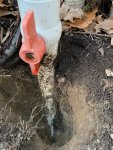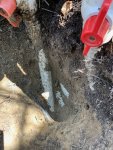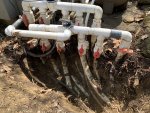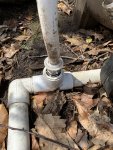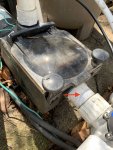We bought a house in 2016 with a pool. The first year we realised that one of the return valves for the spa at our equipment pad was leaking. We've tried to get pool companies to quote us on fixing it, but none of them seem to want to do it - it seems to be too much effort for a quick visit but not enough effort for them to dedicate time to doing it. One company tried a temporary fix (basically filling the crack in the valve with pvc cement) but that lasted about a week. So we've been using the spa with just one set of jets turned on for 2 years. We decided last fall that this spring we'd try and fix it ourselves.
Part of the problem is probably that whoever put in the plumbing put it in very low to the ground and didn't leave much room for maneuvering. Here's a picture from a couple of years ago.
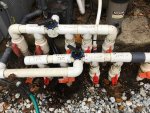
As you can see, the front row of valves (and it's the 3rd one from the left that would need replaced) is at or just above ground level. Then there's the way that the main return pipe from the heater cuts across the top of 3 of the valves. Why did they put in the standpipe that we use for our hose so it presses against the main return pipe? Finally, there's the way that everything is very close together, so while it's just one valve that has a problem (a close-up of that one is below), I don't see an easy way of cutting just that one out and replacing it because there wouldn't be enough pipe left to attach a new valve to.
Does anyone have any suggestions for the best way to fix this? I'd prefer at this point to just replace the return valves (I'm accepting that it'd be a whole row that needs replaced) given the cost of decent valves, and the slightly weakened financial straits that we (along with many others, though at least I'm still working full time while my wife isn't) find ourselves in. Should I try and raise that whole section back to the piping from the heater so that it's higher up? Is there any easy way of moving things further apart (I don't know if adding angles to any of this will negatively affect return flow)?
Adding to my stress over this is that my PVC plumbing experience is close to none
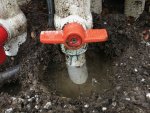
Part of the problem is probably that whoever put in the plumbing put it in very low to the ground and didn't leave much room for maneuvering. Here's a picture from a couple of years ago.

As you can see, the front row of valves (and it's the 3rd one from the left that would need replaced) is at or just above ground level. Then there's the way that the main return pipe from the heater cuts across the top of 3 of the valves. Why did they put in the standpipe that we use for our hose so it presses against the main return pipe? Finally, there's the way that everything is very close together, so while it's just one valve that has a problem (a close-up of that one is below), I don't see an easy way of cutting just that one out and replacing it because there wouldn't be enough pipe left to attach a new valve to.
Does anyone have any suggestions for the best way to fix this? I'd prefer at this point to just replace the return valves (I'm accepting that it'd be a whole row that needs replaced) given the cost of decent valves, and the slightly weakened financial straits that we (along with many others, though at least I'm still working full time while my wife isn't) find ourselves in. Should I try and raise that whole section back to the piping from the heater so that it's higher up? Is there any easy way of moving things further apart (I don't know if adding angles to any of this will negatively affect return flow)?
Adding to my stress over this is that my PVC plumbing experience is close to none




